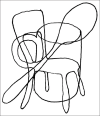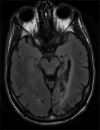Cerebral Visual Loss
- PMID: 36589033
- PMCID: PMC9795709
- DOI: 10.4103/aian.aian_136_22
Cerebral Visual Loss
Abstract
Cerebral visual disorders include a range of common and rare deficits. They can be divided into effects on low-, intermediate-, and high-level forms of visual processing. Low-level deficits are various forms of homonymous hemifield scotomata, which affect all types of vision within their borders. Intermediate-level deficits refer to impairments of colour or motion perception, which affect either one hemifield or the entire field when lesions are bilateral. High-level deficits are divided into those of the ventral (occipitotemporal) or dorsal (occipitoparietal) stream. Occipitotemporal lesions affect various aspects of object recognition, ranging from general visual agnosia to selective agnosias, such as prosopagnosia or topographagnosia from right or bilateral lesions, and pure alexia from left-sided lesions. Occipitoparietal lesions cause the various components of Bálint syndrome, namely, simultanagnosia, optic ataxia, and ocular motor apraxia. They can also cause other impairments of visuospatial or visuotemporal processing, such as astereopsis and sequence-agnosia. Because of anatomic proximity, certain deficits cluster together to form a number of cerebral visual syndromes. Treatment of these disorders remains challenging, with frequent reliance on strategic substitutions rather than restorative approaches.
Keywords: Agnosia; balint; hemianopia.
Copyright: © 2022 Annals of Indian Academy of Neurology.
Conflict of interest statement
There are no conflicts of interest.
Figures










Similar articles
-
Disorders of color and object recognition: syndromes of the ventral occipitotemporal pathway.Continuum (Minneap Minn). 2010 Aug;16(4 Behavioral Neurology):111-27. doi: 10.1212/01.CON.0000368264.61286.9b. Continuum (Minneap Minn). 2010. PMID: 22810517
-
Disorders of higher visual processing.Handb Clin Neurol. 2011;102:223-61. doi: 10.1016/B978-0-444-52903-9.00015-7. Handb Clin Neurol. 2011. PMID: 21601069 Review.
-
Higher cortical visual deficits.Continuum (Minneap Minn). 2014 Aug;20(4 Neuro-ophthalmology):922-41. doi: 10.1212/01.CON.0000453311.29519.67. Continuum (Minneap Minn). 2014. PMID: 25099101 Free PMC article.
-
The Visual Agnosias and Related Disorders.J Neuroophthalmol. 2018 Sep;38(3):379-392. doi: 10.1097/WNO.0000000000000556. J Neuroophthalmol. 2018. PMID: 28945627 Review.
-
Disorder of higher visual function.Curr Opin Neurol. 2011 Feb;24(1):1-5. doi: 10.1097/WCO.0b013e328341a5c2. Curr Opin Neurol. 2011. PMID: 21102334 Review.
Cited by
-
Beyond Words: A Case of Pure Alexia Following Posterior Cerebral Artery Occlusion.Cureus. 2024 Jan 22;16(1):e52734. doi: 10.7759/cureus.52734. eCollection 2024 Jan. Cureus. 2024. PMID: 38384633 Free PMC article.
-
Akinetopsia: a systematic review on visual motion blindness.Front Neurol. 2025 Feb 10;15:1510807. doi: 10.3389/fneur.2024.1510807. eCollection 2024. Front Neurol. 2025. PMID: 39996018 Free PMC article.
References
-
- Shahinfar S, Johnson LN, Madsen RW. Confrontation visual field loss as a function of decibel sensitivity loss on automated static perimetry. Implications on the accuracy of confrontation visual field testing. Ophthalmology. 1995;102:872–7. - PubMed
-
- Zeki SM. A century of cerebral achromatopsia. Brain. 1990;113:1721–77. - PubMed
-
- Bouvier SE, Engel SA. Behavioral deficits and cortical damage loci in cerebral achromatopsia. Cereb Cortex. 2006;16:183–91. - PubMed

